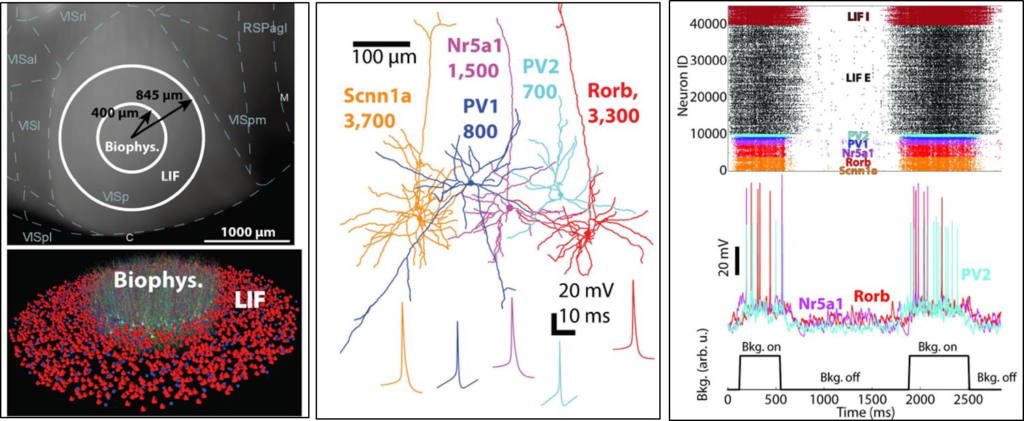Arkhipov, A., Gouwens, N. W., Billeh, Y. N., Gratiy, S., Iyer, R., Wei, Z., … & Koch,
C. (2018). Visual physiology of the layer 4 cortical circuit in silico. PLoS computational biology,
14(11), e1006535.
https://journals.plos.org/ploscompbiol/article?id=10.1371/journal.pcbi.1006535
Large-scale, biophysically-realistic simulation of an experimentally wellcharacterized brain region for direct comparison to in vivo recordings. 10,000 biophysically
modeled neurons. Statistically determined synaptic connectivity.
Mouse primary visual cortex (V1) Layer 4 (driven by spatiotemporal filter model of
LGN)

Authors created a biophysically-realistic model of Layer 4 of mouse primary visual
cortex and tuned particular parameters (e.g. synaptic connectivity) as needed to achieve
agreement with a wide variety of in vivo observations from existing literature. The details of the
model, which parameters needed to be tuned, and its agreement (and disagreement) with in
vivo measurements represents “a consistent summary of our collective anatomical and
physiological knowledge about this region”.
Brief description of model: The model consists of 10,000 biophysically modeled neurons (3
excitatory types, 2 inhibitory types) each consisting of 100-200 dendritic compartments. Soma
dynamics were modeled in Hodgkin-Huxley style using 10 different types of active
conductances to model spiking and spike adaptation. Dendrite structure was based on filled
reconstructed neurons of each type. Only passive dendrite dynamics were modeled. Synapses
were modeled using a bi-exponential model with no short or long-term plasticity. LGN inputs
were modeled by a range of spatiotemporal filters distributed across the visual field: “To connect
LGN cells to L4 cells, we created separate “lasso” subfields for each of three LGN types
(transient ON, OFF, and ON/OFF), independently for each L4 cell… For the excitatory L4 target
cells, the choice of the direction in which the ON and OFF lasso subfields were positioned (Fig
7C) was determined by the assigned preferred orientation angle that was set for each L4 cell at
model construction.”
